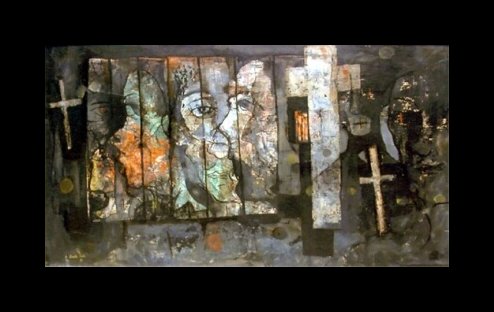Angel Acosta Leon (1930-1964)
Get a Angel Acosta Leon (1930-1964) Certificate of Authenticity for your painting (COA) for your Angel Acosta Leon (1930-1964) drawing.
For all your Angel Acosta Leon (1930-1964) artworks you need a Certificate of Authenticity (COA) in order to sell, to insure or to donate for a tax deduction.
Getting a Angel Acosta Leon (1930-1964) Certificate of Authenticity (COA) is easy. Just send us photos and dimensions and tell us what you know about the origin or history of your Angel Acosta Leon (1930-1964) painting or drawing.
If you want to sell your Angel Acosta Leon (1930-1964) painting or drawing use our selling services. We offer Angel Acosta Leon (1930-1964) selling help, selling advice, private treaty sales and full brokerage.
We have been authenticating Angel Acosta Leon (1930-1964) and issuing certificates of authenticity since 2002. We are recognized Angel Acosta Leon (1930-1964) experts and Angel Acosta Leon (1930-1964) certified appraisers. We issue COAs and appraisals for all Angel Acosta Leon (1930-1964) artworks.
Our Angel Acosta Leon (1930-1964) paintings and drawings authentications are accepted and respected worldwide.
Each COA is backed by in-depth research and analysis authentication reports.
The Angel Acosta Leon (1930-1964) certificates of authenticity we issue are based on solid, reliable and fully referenced art investigations, authentication research, analytical work and forensic studies.
We are available to examine your Angel Acosta Leon (1930-1964) painting or drawing anywhere in the world.
You will generally receive your certificates of authenticity and authentication report within two weeks. Some complicated cases with difficult to research Angel Acosta Leon (1930-1964) paintings or drawings take longer.
Our clients include Angel Acosta Leon (1930-1964) collectors, investors, tax authorities, insurance adjusters, appraisers, valuers, auctioneers, Federal agencies and many law firms.
We perform Angel Acosta Leon art authentication, appraisal, certificates of authenticity (COA), analysis, research, scientific tests , full art authentications. We will help you sell your Angel Acosta Leon or we will sell it for you.
Disregarded as a painter of Cuban themes, brought up in a poor family and otherwise forgotten by critics during his lifetime, Angel Acosta Leon led a tragic life.
Studying at San Alejandro in his youth, Acosta created art for only nine years, five of which were after he matured as a painter. His earliest paintings were oils of the sea and harbor and of tree lined parks. He is generally not well-known for these early works, so there is an excellent chance of one of these paintings surfacing somewhere.
From the very beginning, Acosta struggled as a painter. His family was poor, and did not understand his need to paint. He often lived in cramped situations, and not until he was much older could he afford to move out of his family’s house and into a room at a Havana mansion. This familial alienation would become an underlying current in his works.
Acosta had many themes in his work, another of which was sickness and death. He often painted syringes and crosses along with faces in his art. Some people say crosses were a sign that he had syphilis, therefore making these very powerful statements. A great example of his inclusion of crosses is “Rostros y Cruces” (1959), which translates into “Faces and Crosses.” Take notice of how the smaller crosses appear to almost look like syringes.

Interestingly, from 1958-1959, Acosta painted an extensive series of self-portraits, much in the same way that Frida Kahlo and Vincent Van Gogh did. To this day, Acosta has painted more self-portraits than any other Cuban painter.
Throughout the many struggles in his life, Acosta was never able to fully support himself with his art alone. To make ends meet he became a tinsmith, a welder and a conductor at a bus station. This work made a heavy impact on his art, and he began to incorporate metallics in his compositions. He also used machinery intertwined with organic elements. During his lifetime, Acosta also created pottery. Toward the end of his life, he began to paint more abstractly and infused Cubist ideas into his work.
Acosta won a number of awards and exhibited his work all over Cuba and Europe, but his critics failed to see the true potential of his work. He was not typically seen as a part of the Vanguard movement, and was lost among other more famous painters of the time such as Lam. In truth, he is just as much a part of the Vanguards as anyone else. His use of machinery in place of organic elements echoed the political unrest of the country at the time and was truly a social statement.
On a trip back to Cuba from Paris, Acosta attempted suicide a number of times, and finally succeeded by throwing himself into the sea. He left behind him a large oeuvre, which is now housed all over the world.
Think you own a painting by this amazing artist? Contact Art Experts. We provide art art authentications, art appraisals, art research, and COA's, as well as consultations, for all paintings by Angel Acosta Leon.
